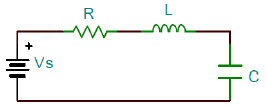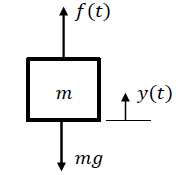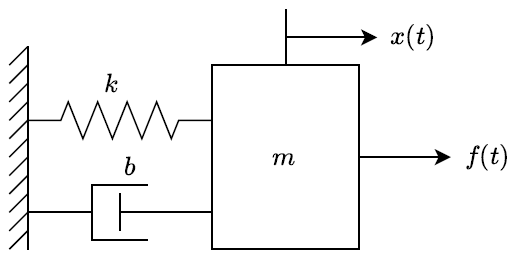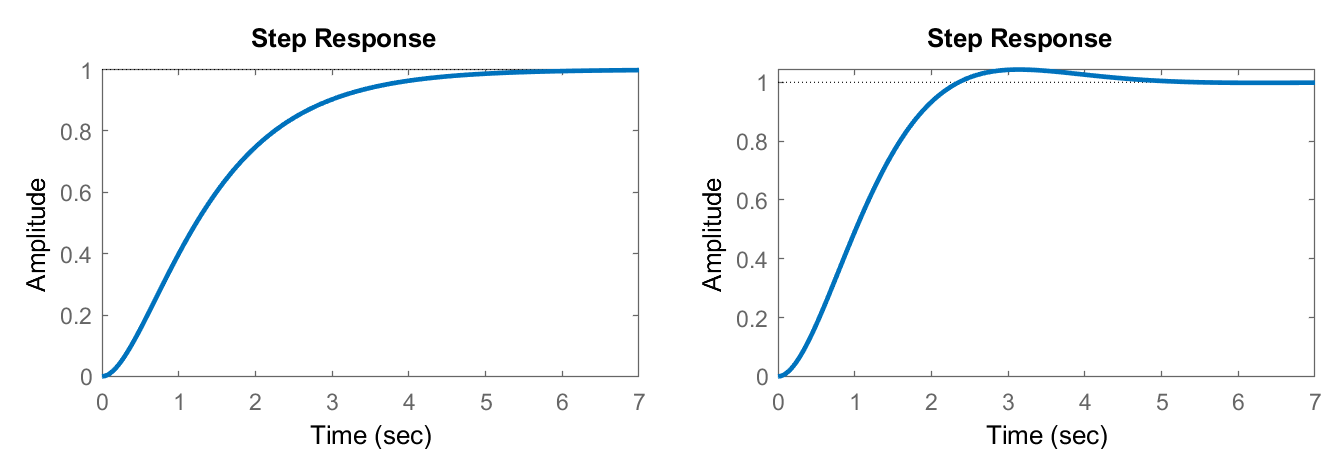1.3: Second-Order ODE Models
- Page ID
- 24385
\( \newcommand{\vecs}[1]{\overset { \scriptstyle \rightharpoonup} {\mathbf{#1}} } \)
\( \newcommand{\vecd}[1]{\overset{-\!-\!\rightharpoonup}{\vphantom{a}\smash {#1}}} \)
\( \newcommand{\id}{\mathrm{id}}\) \( \newcommand{\Span}{\mathrm{span}}\)
( \newcommand{\kernel}{\mathrm{null}\,}\) \( \newcommand{\range}{\mathrm{range}\,}\)
\( \newcommand{\RealPart}{\mathrm{Re}}\) \( \newcommand{\ImaginaryPart}{\mathrm{Im}}\)
\( \newcommand{\Argument}{\mathrm{Arg}}\) \( \newcommand{\norm}[1]{\| #1 \|}\)
\( \newcommand{\inner}[2]{\langle #1, #2 \rangle}\)
\( \newcommand{\Span}{\mathrm{span}}\)
\( \newcommand{\id}{\mathrm{id}}\)
\( \newcommand{\Span}{\mathrm{span}}\)
\( \newcommand{\kernel}{\mathrm{null}\,}\)
\( \newcommand{\range}{\mathrm{range}\,}\)
\( \newcommand{\RealPart}{\mathrm{Re}}\)
\( \newcommand{\ImaginaryPart}{\mathrm{Im}}\)
\( \newcommand{\Argument}{\mathrm{Arg}}\)
\( \newcommand{\norm}[1]{\| #1 \|}\)
\( \newcommand{\inner}[2]{\langle #1, #2 \rangle}\)
\( \newcommand{\Span}{\mathrm{span}}\) \( \newcommand{\AA}{\unicode[.8,0]{x212B}}\)
\( \newcommand{\vectorA}[1]{\vec{#1}} % arrow\)
\( \newcommand{\vectorAt}[1]{\vec{\text{#1}}} % arrow\)
\( \newcommand{\vectorB}[1]{\overset { \scriptstyle \rightharpoonup} {\mathbf{#1}} } \)
\( \newcommand{\vectorC}[1]{\textbf{#1}} \)
\( \newcommand{\vectorD}[1]{\overrightarrow{#1}} \)
\( \newcommand{\vectorDt}[1]{\overrightarrow{\text{#1}}} \)
\( \newcommand{\vectE}[1]{\overset{-\!-\!\rightharpoonup}{\vphantom{a}\smash{\mathbf {#1}}}} \)
\( \newcommand{\vecs}[1]{\overset { \scriptstyle \rightharpoonup} {\mathbf{#1}} } \)
\( \newcommand{\vecd}[1]{\overset{-\!-\!\rightharpoonup}{\vphantom{a}\smash {#1}}} \)
\(\newcommand{\avec}{\mathbf a}\) \(\newcommand{\bvec}{\mathbf b}\) \(\newcommand{\cvec}{\mathbf c}\) \(\newcommand{\dvec}{\mathbf d}\) \(\newcommand{\dtil}{\widetilde{\mathbf d}}\) \(\newcommand{\evec}{\mathbf e}\) \(\newcommand{\fvec}{\mathbf f}\) \(\newcommand{\nvec}{\mathbf n}\) \(\newcommand{\pvec}{\mathbf p}\) \(\newcommand{\qvec}{\mathbf q}\) \(\newcommand{\svec}{\mathbf s}\) \(\newcommand{\tvec}{\mathbf t}\) \(\newcommand{\uvec}{\mathbf u}\) \(\newcommand{\vvec}{\mathbf v}\) \(\newcommand{\wvec}{\mathbf w}\) \(\newcommand{\xvec}{\mathbf x}\) \(\newcommand{\yvec}{\mathbf y}\) \(\newcommand{\zvec}{\mathbf z}\) \(\newcommand{\rvec}{\mathbf r}\) \(\newcommand{\mvec}{\mathbf m}\) \(\newcommand{\zerovec}{\mathbf 0}\) \(\newcommand{\onevec}{\mathbf 1}\) \(\newcommand{\real}{\mathbb R}\) \(\newcommand{\twovec}[2]{\left[\begin{array}{r}#1 \\ #2 \end{array}\right]}\) \(\newcommand{\ctwovec}[2]{\left[\begin{array}{c}#1 \\ #2 \end{array}\right]}\) \(\newcommand{\threevec}[3]{\left[\begin{array}{r}#1 \\ #2 \\ #3 \end{array}\right]}\) \(\newcommand{\cthreevec}[3]{\left[\begin{array}{c}#1 \\ #2 \\ #3 \end{array}\right]}\) \(\newcommand{\fourvec}[4]{\left[\begin{array}{r}#1 \\ #2 \\ #3 \\ #4 \end{array}\right]}\) \(\newcommand{\cfourvec}[4]{\left[\begin{array}{c}#1 \\ #2 \\ #3 \\ #4 \end{array}\right]}\) \(\newcommand{\fivevec}[5]{\left[\begin{array}{r}#1 \\ #2 \\ #3 \\ #4 \\ #5 \\ \end{array}\right]}\) \(\newcommand{\cfivevec}[5]{\left[\begin{array}{c}#1 \\ #2 \\ #3 \\ #4 \\ #5 \\ \end{array}\right]}\) \(\newcommand{\mattwo}[4]{\left[\begin{array}{rr}#1 \amp #2 \\ #3 \amp #4 \\ \end{array}\right]}\) \(\newcommand{\laspan}[1]{\text{Span}\{#1\}}\) \(\newcommand{\bcal}{\cal B}\) \(\newcommand{\ccal}{\cal C}\) \(\newcommand{\scal}{\cal S}\) \(\newcommand{\wcal}{\cal W}\) \(\newcommand{\ecal}{\cal E}\) \(\newcommand{\coords}[2]{\left\{#1\right\}_{#2}}\) \(\newcommand{\gray}[1]{\color{gray}{#1}}\) \(\newcommand{\lgray}[1]{\color{lightgray}{#1}}\) \(\newcommand{\rank}{\operatorname{rank}}\) \(\newcommand{\row}{\text{Row}}\) \(\newcommand{\col}{\text{Col}}\) \(\renewcommand{\row}{\text{Row}}\) \(\newcommand{\nul}{\text{Nul}}\) \(\newcommand{\var}{\text{Var}}\) \(\newcommand{\corr}{\text{corr}}\) \(\newcommand{\len}[1]{\left|#1\right|}\) \(\newcommand{\bbar}{\overline{\bvec}}\) \(\newcommand{\bhat}{\widehat{\bvec}}\) \(\newcommand{\bperp}{\bvec^\perp}\) \(\newcommand{\xhat}{\widehat{\xvec}}\) \(\newcommand{\vhat}{\widehat{\vvec}}\) \(\newcommand{\uhat}{\widehat{\uvec}}\) \(\newcommand{\what}{\widehat{\wvec}}\) \(\newcommand{\Sighat}{\widehat{\Sigma}}\) \(\newcommand{\lt}{<}\) \(\newcommand{\gt}{>}\) \(\newcommand{\amp}{&}\) \(\definecolor{fillinmathshade}{gray}{0.9}\)
A physical system that contains two energy storage elements is described by a second-order ODE. Examples of second-order models are discussed below:
A series RLC circuit with voltage input \(V_s(t)\) and current output \(i(t)\) has a governing relationship obtained by applying the Kirchoff’s voltage law to the mesh (Figure \(\PageIndex{1}\)):
\[ L\frac{ di(t)}{ dt} +Ri(t)+\frac{1}{C} \int i(t) dt=V_ s (t) \nonumber \]
The above integro-differential equation can by converted into a second-order ODE by expressing it in terms of the electric charge, \(q(t)\), as:
\[ L\frac{ d^{2} q(t)}{ dt^{2} } +R\frac{ dq(t)}{ dt} +\frac{1}{C} q(t)=V_ s (t) \nonumber \]
Alternatively, the series RLC circuit can be described in terms of two first-order ODE’s involving natural variables, the current, \(i(t)\), and the capacitor voltage, \(V_c(t)\), as:
\[ L\frac{ di(t)}{ dt} +Ri(t)+V_{c} (t)=V_s (t), \ \ \ \ \ C\frac{dV_c}{dt}=i(t) \nonumber \]

The motion of a mass element of weight, \(mg\), pulled upward by a force, \(f(t)\), is described using position output, \(y(t)\), by a second-order ODE:
\[ m\frac{ d^{2} y(t)}{ dt^{2} } +mg=f(t) \nonumber \]
The second-order ODE expresses the fact that the moving mass has both the kinetic and potential energies (Figure \(\PageIndex{2}\)).

A mass–spring–damper system includes a mass affected by an applied force, \(f(t)\); its motion is restrained by a combination of a spring and a damper (Figure 1.8).
Let \(x(t)\) denote the displacement of the mass from a fixed reference; then, the dynamic equation of the system, obtained by using Newton’s second law of motion, takes a familiar form:
\[m\frac{ d^{2} x(t)}{ dt^{2} } +b\frac{ dx(t)}{ dt} +kx(t)=f(t) \nonumber \]
In compact notation, we may express the ODE as: \[m\ddot{x}\; +\; b\dot{x}\; +\; kx=f \nonumber \]
where the dots above the variable represent time derivative, i.e., \(\dot{x}\left(t\right)=\frac{dx\left(t\right)}{dt}\), \(\ddot{x}\left(t\right)=\frac{d^2x\left(t\right)}{dt^2}\).
Using position, \(x(t)\), and velocity, \(v(t)\) as variables, the mass-spring-damper system is described by two first-order equations (called state equations) given as: \[ \frac{dx}{dt}=v(t), \ \ \ \ \ \frac{dv}{dt}=\frac{1}{m} \left(-kx(t)-bv(t)+f(t) \right) \nonumber \]
In the absence of damping, the dynamic equation of the mass-spring system reduces to:
\[m\frac{d^2x\left(t\right)}{dt^2}+kx\left(t\right)=f(t) \nonumber \]
The above equation describes simple harmonic motion (SHM) with \({\omega }^2_0=k/m\). From elementary physics, the general solution to the equation is given as:
\[x\left(t\right)=A{cos {\omega }_0\ }t+B{sin {\omega }_0t\ } \nonumber \]

Solving Second-Order Models
A second-order ODE model can be solved by applying the Laplace transform to both sides of the differential equation. Let a general second-order ODE model be described as:
\[\ddot{y}\left(t\right)+a_1\dot{y}\left(t\right)+a_2y\left(t\right)=b_1\dot{u}\left(t\right)+b_2u\left(t\right) \nonumber \]
Application of the Laplace transform, assuming the following initial conditions: \(y\left(0\right)=y_0,\ \ \dot{y}\left(0\right)={\dot{y}}_0, \ \ u(0)=0\), gives:
\[\left(s^2+a_1s+a_2\right)y\left(s\right)-\left(s+a_1\right)y_0-{\dot{y}}_0=\left(b_1s+b_2\right)u\left(s\right) \nonumber \]
or,
\[y\left(s\right)=\frac{1}{s^2+a_1s+a_2}\left[\left(s+a_1\right)y_0+{\dot{y}}_0+\left(b_1s+b_2\right)u\left(s\right)\right] \nonumber \]
Transfer Function
By applying Laplace transform assuming no initial conditions, we obtain: \(\left(s^2+a_1s+a_2\right)y\left(s\right)=(b_1s+b_2)u(s)\); the resulting input-output transfer function is given as:
\[\frac{y\left(s\right)}{u\left(s\right)}=\frac{b_1s+b_2}{s^2+a_1s+a_2} \nonumber \]
The characteristic equation of the model is defined as: \(s^{2} +a_{1} s+a_{2} =0\).
For the mass–spring–damper model described by: \(m\ddot{x}\; +\; b\dot{x}\; +\; kx=f\) (Example 1.3.3), the transfer function from force input to displacement output is given as:
\[\frac{x(s)}{f(s)} =\frac{1}{ms^{2} +bs+k} \nonumber \]
Transfer function of a physical systems is a proper fraction, i.e., the degree of the denominator polynomial is greater than the degree of numerator polynomial.
The roots of its denominator polynomial characterize the response of the second-order ODE model. The response is monotonic in the case of real roots, and oscillatory for complex roots.
Consider the mass-spring-damper model (Example \(\PageIndex{3}\)), where the following parameter values are assumed: \(m=1\), \(k=2\), and \(b=3\). Then, the second-order ODE is given as:
\[\ddot{x}\left(t\right)+3\dot{x}\left(t\right)+2x\left(t\right)=f\left(t\right) \nonumber \]
The application of the Laplace transform assuming zero initial conditions gives: \[(s^2+3s+2)y\left(s\right)=f(s) \nonumber \]
The characteristic equation of the model is given as: \(s^2+3s+2=0\). The equation has real roots at: \(s=-1,\ -2\).
Next, let \(f\left(t\right)=2u\left(t\right),\ f\left(s\right)=\frac{2}{s}\); then, the output is solved as: \[x\left(s\right)=\frac{2}{s\left(s+1\right)\left(s+2\right)} \nonumber \]
We use partial fraction expansion (PFE) to obtain:
\[x(s)=\frac{1}{s}-\frac{2}{s+1}+\frac{1}{s+2} \nonumber \]
By applying the inverse Laplace transform, the output response of the spring-mass-damper system is obtained as (Figure 1.9):
\[x\left(t\right)=\left(1-2e^{-t}+e^{-2t}\right)u(t) \nonumber \]
where \(u\left(t\right)\) represents the unit-step function.
Note: The solution of an ODE generally involves the PFE. We may use the online SimboLab partial fraction calculator for this purpose (https://www.symbolab.com/solver/part...ns-calculator/).
Consider the mass-spring-damper model (Example \(\PageIndex{3}\)), with following parameter values: \(m=1,\ k=2,\ b=2\). Then, the second-order ODE is given as:
\[\ddot{x}\left(t\right)+2\dot{x}\left(t\right)+2x\left(t\right)=f\left(t\right) \nonumber \]
The application of the Laplace transform assuming zero initial conditions gives:
\[(s^2+2s+2)y\left(s\right)=f(s) \nonumber \]
The characteristic equation of the model is given as: \(s^2+2s+2=0\). The equation has complex roots at: \(s=-1\pm j1\).
Let \(f\left(t\right)=2u\left(t\right),\ f\left(s\right)=2/s\); then, the output is solved as:
\[x\left(s\right)=\frac{2}{s\left(s^2+2s+2\right)} \nonumber \]
Next, a PFE of the output is carried out to obtain:
\[x(s)=\frac{1}{s}-\frac{s+2}{s^2+2s+2} \nonumber \]
The quadratic factor is expressed as: \({\left(s+1\right)}^2+1^2\); the quadratic term is split to obtain:
\[x\left(s\right)=\frac{1}{s}-\frac{s+1}{{\left(s+1\right)}^2+1^2}-\frac{1}{{\left(s+1\right)}^2+1^2} \nonumber \]
By applying the inverse Laplace transform, the output response of the spring-mass-damper system is obtained as (Figure 1.9):
\[x\left(t\right)=\left(1-e^{-t}\cos t -e^{-t}\sin t \right)u\left(t\right) \nonumber \]
where \(u\left(t\right)\) represents the unit-step function.



